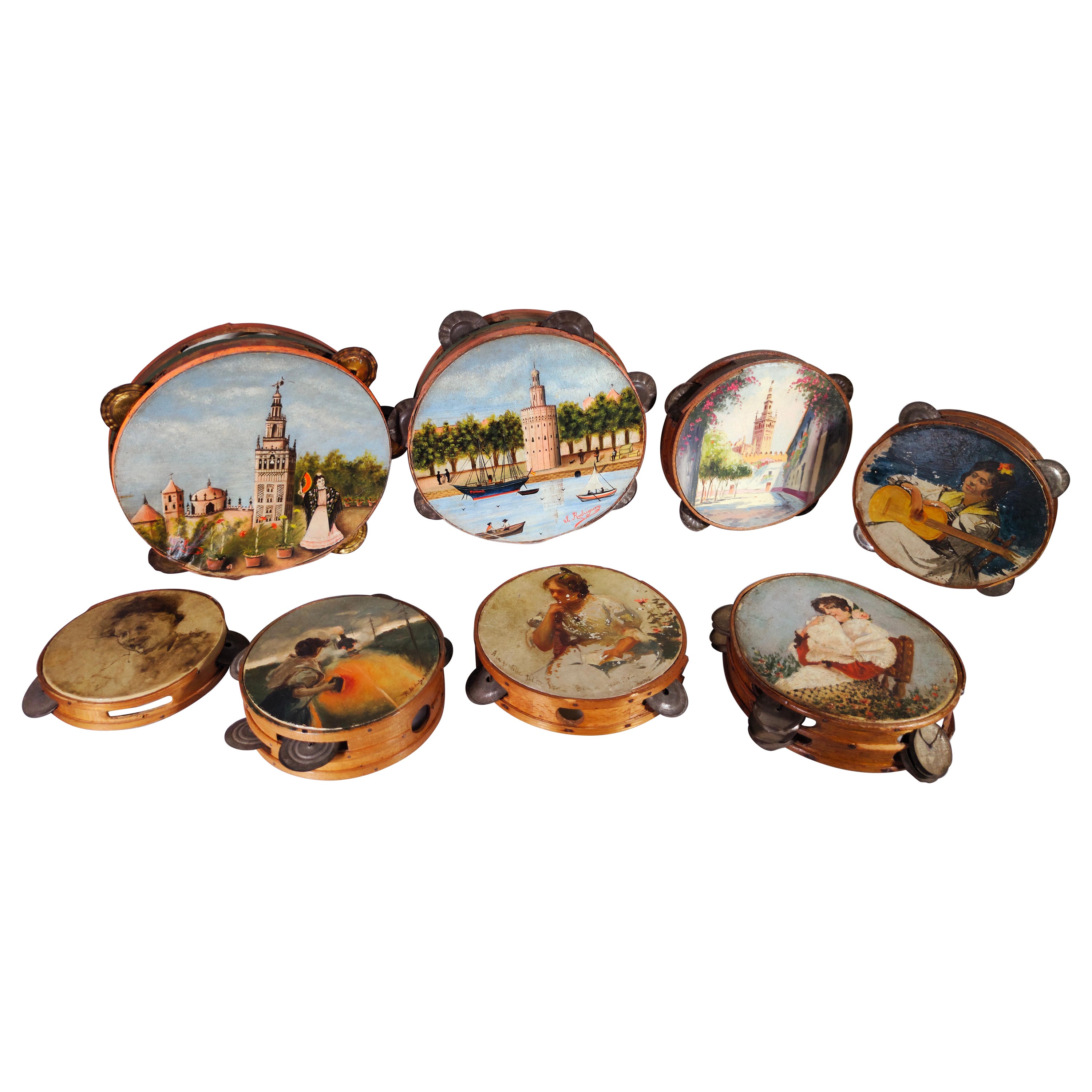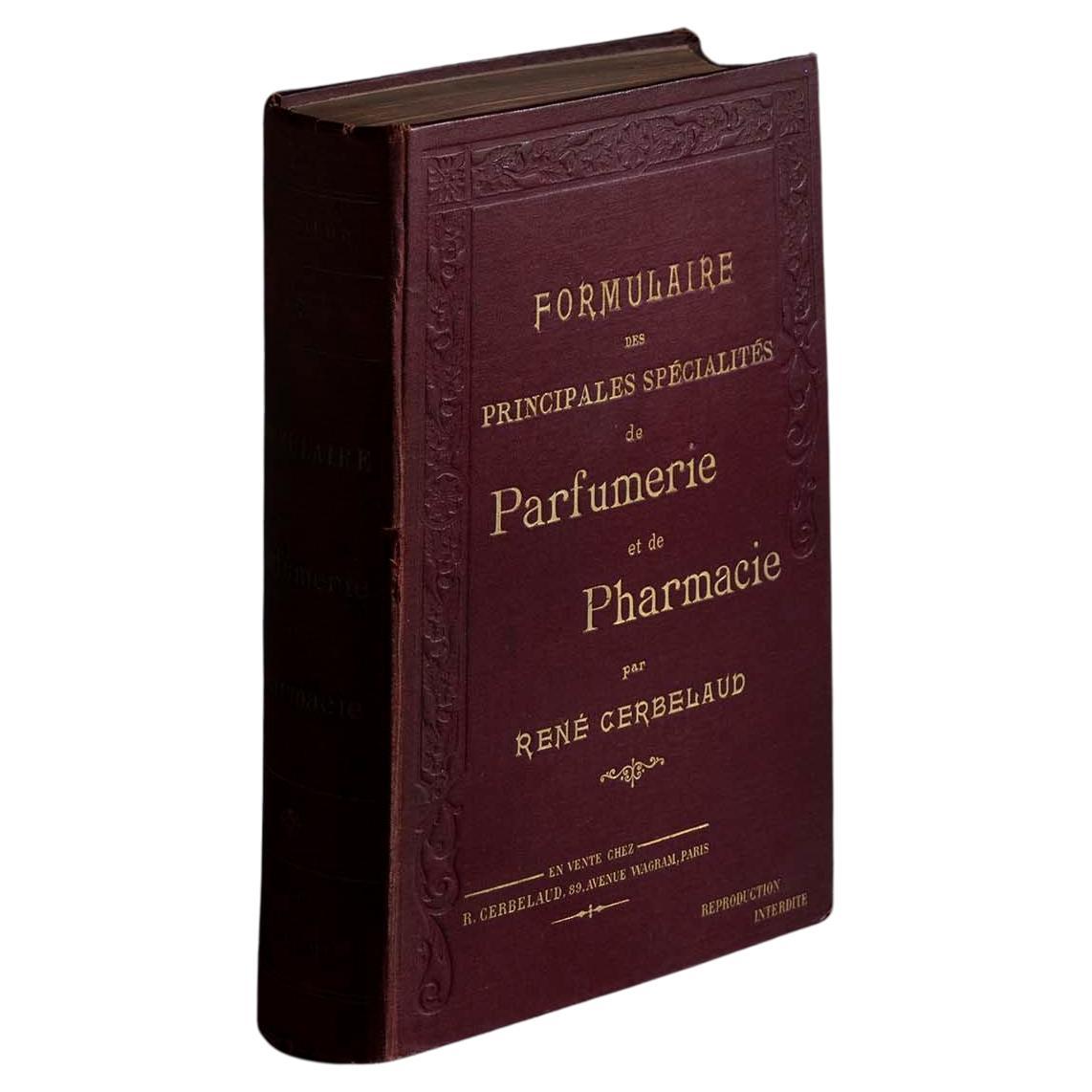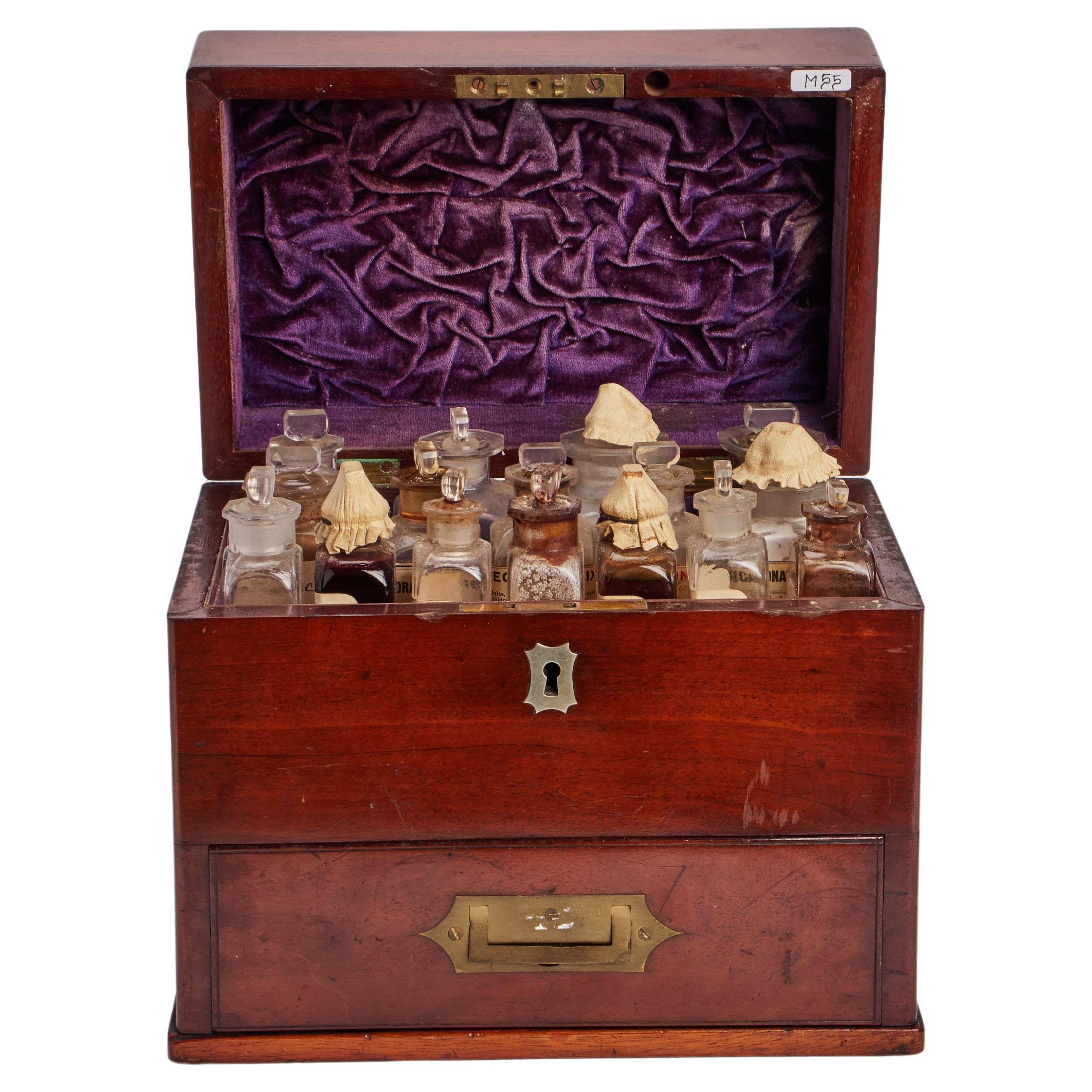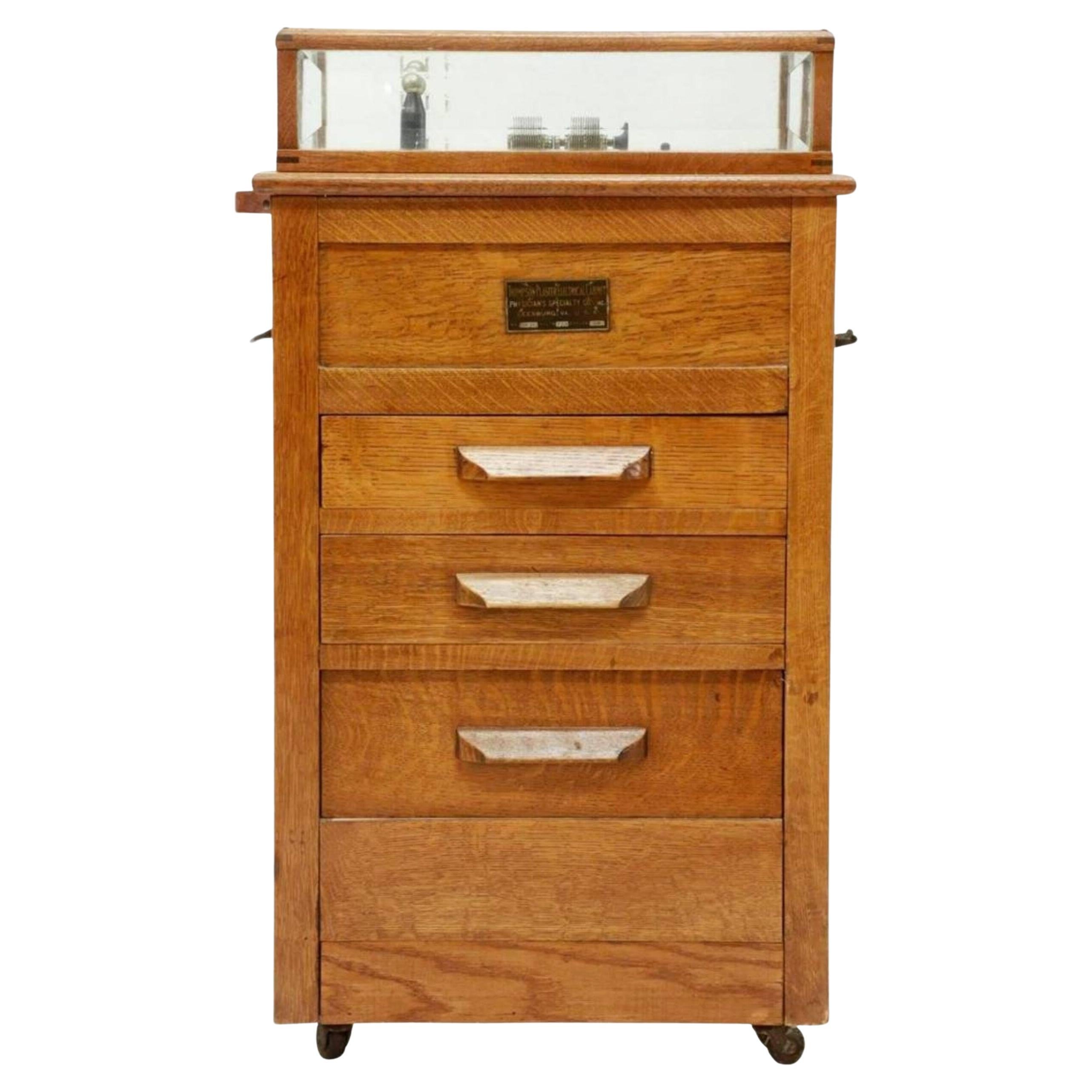Items Similar to XIX Century English Apothecary Set Cabinet Medicines & Perfumery J Hexam Chymist
Want more images or videos?
Request additional images or videos from the seller
1 of 21
XIX Century English Apothecary Set Cabinet Medicines & Perfumery J Hexam Chymist
About the Item
English apothecary cabinet dated to the first half of the nineteenth century, mahogany box, brass handle and hinges and complete with key. The cabinet with a rectangular base is formed by a central compartment with two shutters in which are housed separated by wooden dividers 21 blown glass which contains dusts and chemical preparations. A label is affixed to the blown glass containers:”Patent Medicines & Perfumery J. Hexam Chymist Swansea ecc”.
In the lower part some drawers are arranged, containing a scale with its weights, mortar, pestle, measuring cups, syringes and other objects. Conservation status: very good. Height 27.5 cm - inches 10.82, width 22 cm - inches 8.66, depth 18 cm - inches 7.08.
In use from the Renaissance, apothecary cabinets were born for doctors’ needs to have with themselves the necessaries for the first aid. They were usually a wooden box with several partitions where a few surgical instruments and the necessary for pharmacological therapy were located. Till the last Middle age, pharmacy was a part of medicine. Modern pharmacy’s bases go back to Renaissance. A very important historic moment was the discovery of America in 1492 and the following import of new vegetal species, helping to improve pharmacological study of plants.
- Dimensions:Height: 11 in (27.94 cm)Width: 7.8 in (19.82 cm)Depth: 11.4 in (28.96 cm)
- Materials and Techniques:
- Place of Origin:
- Period:
- Date of Manufacture:1820
- Condition:Wear consistent with age and use.
- Seller Location:Milan, IT
- Reference Number:1stDibs: LU1020226097052
About the Seller
4.9
Platinum Seller
These expertly vetted sellers are 1stDibs' most experienced sellers and are rated highest by our customers.
Established in 1999
1stDibs seller since 2014
370 sales on 1stDibs
Typical response time: <1 hour
- ShippingRetrieving quote...Ships From: Milan, Italy
- Return PolicyA return for this item may be initiated within 3 days of delivery.
More From This SellerView All
- Fassamano Tortoise Antique Eyeglasses French Manufacture XIX centuryLocated in Milan, ITDouble fassamano eyeglasses (from the French face-en-main), made with a double articulated eyewear, one with lenses and one without, mounted on the upper part, signed Lugene, made of...Category
Antique 1860s French Scientific Instruments
MaterialsBakelite
- End XIX Century Brass and Glass Hourglass Antique Time Measuring InstrumentLocated in Milan, ITSand hourglass, brass container with circular base and tapered columns in the center and blown glass cruet. Duration 45 minutes. English manufacture of the early 1900s. Measures height 20 cm, diameter 11.5 cm – 7.9x4.5 inches. Shipping is insured by Lloyd's London; our gift box is free (look at the last picture). In Greece, the use of hourglasses was introduced in 325 BC, in the form of stone containers with a truncated cone shape that let water flow out of a hole in the bottom at a constant rate. Other hourglasses were cylindrical or cup-shaped and were slowly filled by a constant flow of water. Some signs on the inner surface of the container indicated the passage of hours as the liquid level rose. Another version consisted of a metal container with a hole in the bottom which, placed to float in a larger container, sank in a given time. This system remained in use until the 20th century in North Africa. These clocks were typically used at night, but not during the day, when the more accurate sundials were available. In the first half of the III century BC. Ctesibius transformed the hourglass into the more complex water clock. Various mechanisms were introduced by him and others to increase the precision of the watch by regulating the pressure and keeping the flow of water constant, but also to offer a better display of the time. The most advanced specimens could ring bells or gongs, open windows to display images, or had movable indicators, dials or representations of celestial bodies. Among the designers of watches...Category
Antique 1890s Scientific Instruments
MaterialsGlass
- End XIX century Small Terrestrial Globe Signed C.M.C Paris Papier Maché SphereLocated in Milan, ITSmall terrestrial globe signed C.M.C. Paris, end of XIX century. Papier maché sphere and turned and ebonized wooden base. Height cm 13 - inches 5.1, diameter of sphere cm 6,5 - inche...Category
Antique 1890s French Globes
MaterialsPaper
- Bussola a Secco Nella Sua Scatola Originale in Legno Inghilterra xix SecoloLocated in Milan, ITBussola a secco alloggiata nella sua scatola originale in legno con coperchio a feritoia della fine del XIX secolo. La bussola è costituita da un recipiente in ottone e vetro, sul fo...Category
Antique 1880s Nautical Objects
MaterialsBrass
- Polena raffigurante una figura femminile Indie Orientali fine del XIX secoloLocated in Milan, ITPolena raffigurante una figura femminile con i capelli sciolti e una cintura che le stringe la vita; è stata scolpita in legno di tiglio, nome scientifico Tilia, un legno molto usato nei lavori di intaglio, cosa che farebbe pensare a una nave costruita in un cantiere delle Indie Orientali attorno alla fine del XIX secolo, fatto frequente in molte navi della Royal Navy, benché la presente scultura per le fattezze appartiene certamente a una nave mercantile. Le sue dimensioni sono 163 cm di altezza – inches 64.20, 48 cm – inches 18.8 di larghezza massima misurata all’altezza delle spalle e cm 30 – inches 11.8, di profondità. Sotto lo strato di vernice di colore verde chiaro, più recente, ci sono tracce di una colorazione bruno-marrone, probabilmente una pittura usata per la conservazione del legno. La scultura è stata eseguita a mano con uso di sgorbia. La mancanza di braccia è tipica delle polene...Category
Antique Late 19th Century Nautical Objects
MaterialsWood
- Cannocchiale in ottone con impugnatura in Galuchat seconda metà XIX secoloLocated in Milan, ITCannocchiale in ottone a sezione tonda con impugnatura rivestita di Galuchat pelle di razza conciata e messa fuoco a tre allunghi. Manifattura inglese della seconda metà dell'800. Lu...Category
Antique 1870s Nautical Objects
MaterialsBrass
You May Also Like
- Antique Pharmacist's Medicine Cup, English, Glass, Apothecary Measure, VictorianLocated in Hele, Devon, GBThis is an antique pharmacist's medicine cup. An English, glass and leather apothecary measure, dating to the Victorian period, circa 19000. A fa...Category
Antique Late 19th Century British Scientific Instruments
MaterialsGlass
- 8 Tambourines xix CenturyLocated in Madrid, ES8 Tambourines XIX Century 8 TAMBOURINS XIX CENTURY COLLECTION OF 8 ANCIENT TAMBOURINS PAINTED IN OIL AND SIGNS DIAMETER MEASUREMENTS: THE SMALLEST 16 CM A...Category
Antique 1890s Musical Instruments
MaterialsBentwood
- René Cerbelaud's Perfumery and Pharmacy BookLocated in Milano, ITWe invite you to embark on a timeless journey of discovery, as we unveil a genuine relic from the past: René Cerbelaud's rare book, dating back to 1909. Titled "Formulaire des Principales Spécialités de Parfumerie et de Pharmacie par René Cerbelaud," this extraordinary tome is a true repository of secrets and traditions from the captivating worlds of perfumery and pharmacy. Originally published in French and subsequently translated into numerous languages, this book has traversed the centuries, preserving the wisdom of a bygone era. Each page of this precious book holds a story of expertise and passion within the realms of perfumery and pharmacy. Despite more than a century having passed since its publication, the contents of this book continue to exert a fascinating allure. René Cerbelaud meticulously documented a wide range of recipes, including serums, ointments, liqueurs, and various extracts, offering us a comprehensive overview of ancient pharmaceutical and perfumery practices. Reading this book is akin to taking a journey back in time, an extraordinary opportunity to explore the traditions and knowledge of a bygone era. This antique book stands...Category
Antique Early 1900s French French Provincial Books
MaterialsFabric
- Set of Nine 19th C English Victorian Treen Ware Boxwood Medicine Bottle HoldersLocated in Haarlem, NLA set of nine 19th century Victorian treen turned boxwood medicine bottle holders. These containers were used for protecting delicate items such as glass apothecary bottles, perfume bottles, syringes, powder, ointment bottles, thermometers and other medical or vanity items. In two of the containers are glass bottles. Measurements: Large 18.5cm high, 8.5cm diameter, empty Large 18cm high, 8cm diameter, empty Medium 14.5cm high, 5.5cm diameter, glass bottle without stopper (wood chipped) Medium 13cm high, 6cm diameter, empty (crack in wood) Medium 12cm high, 5cm diameter, perfumed oil in glass bottle Medium 11cm high, 5cm diameter, empty Small 10cm high, 4cm diameter, talcum powder...Category
Antique Mid-19th Century British Victorian Scientific Instruments
MaterialsGlass, Boxwood
- Apothecary Traveling Set, England 1790Located in Milan, ITMahogany and brass box, with a drawer in the front. The upper part opens and inside a group of glass bottles ( some with labels), placed in comp...Category
Antique Late 18th Century British Scientific Instruments
MaterialsBrass
- Unusual Early American Quack Medicine Thompson-Plaster Electric CabinetLocated in Forney, TXA rare and most unusual Thompson-Plaster electrical cabinet, by Physician's Specialty Company, Leesburg, Virginia, United States. The historic turn of the late 19th / early 20th century quack medicine machine used a violent ray electrotherapy apparatus as a cure-all, claiming to cure numerous ailments, cancers, and more. Featuring the original oak framed glazed glass-covered marble top for use with 'medical' instruments, atop quartersawn oak chest fitted with three graduated drawers, opening to reveal various associated equipment and supplies, including blown glass evacuated tube implements of varying shapes and for different therapeutic uses. High-quality solid wood case, rising on castors. Signed, retaining the original manufacturer plaque. Museum quality. Provenance / Acquisition: Reportedly purchased by Dr. Slaughter, of Goldthwaite, Texas, May, 1903. Acquired from highly reputable auction house, Austin Auction Gallery, established 1983, Austin, Texas. Day 2 of 3, Important Estates catalog. 2021 Similar examples can be found in select museum collections and exhibitions, including Loudoun Museum, Leesburg, Virginia. Holmes Medical Museum, Foley, Alabama. Dimensions: (approx) 40.75" High, 26" Wide, 17.5" Deep Condition: Excellent original antique condition. Museum quality. Unknown if complete. Wear consistent with age and use. A scarce example of medical quackery...Category
Early 20th Century American Cabinets
MaterialsMarble
Recently Viewed
View AllMore Ways To Browse
Measuring Cups
Measuring Cup
Antique Handles And Hinges
18 Century English Furniture
18the Century Furniture English
Antique Measuring Cups
English Antique Imports
Antique Glass Containers
Antique Glass Container
Mahogany Plant
1820 Cup
Wooden Box With Key
English Wooden Boxes
Antique Brass Containers
Antique Brass Container
Renaissance Cups
English Container
Pharmacy Glass





